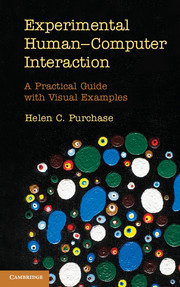Book contents
- Frontmatter
- Contents
- List of experiments
- Acknowledgements
- Preface
- 1 Introduction
- 2 Defining the research
- 3 Experimental procedure
- 4 Data collection and qualitative analysis
- 5 Statistics
- 6 Reporting
- 7 Problems and pitfalls
- 8 Six principles for conducting experiments
- Appendix A1 Independent measures examples
- Appendix A2 Statistical formulae
- Appendix A3 Factor analysis example
- Bibliography
- References
- Index
1 - Introduction
Published online by Cambridge University Press: 05 August 2012
- Frontmatter
- Contents
- List of experiments
- Acknowledgements
- Preface
- 1 Introduction
- 2 Defining the research
- 3 Experimental procedure
- 4 Data collection and qualitative analysis
- 5 Statistics
- 6 Reporting
- 7 Problems and pitfalls
- 8 Six principles for conducting experiments
- Appendix A1 Independent measures examples
- Appendix A2 Statistical formulae
- Appendix A3 Factor analysis example
- Bibliography
- References
- Index
Summary
This book describes the process that takes a researcher from identifying ahuman–computer interaction (HCI) research idea that needs to be tested,to designing and conducting a test, and then analysing and reporting theresults. This first chapter introduces the notion of an “HCI idea”and different approaches to testing.
Assessing the worth of an HCI idea
Imagine that you have an HCI idea, for example, a novel interaction method, a newway of visualising data, an innovative device for moving a cursor, or a newinteractive system for building games. You can implement it, demonstrate it to awide range of people, and even deploy it for use – but is it a“good” idea? Will the interaction method assist users with theirtasks? Will the visualisation make it easier to spot data trends? Will the newdevice make cursor movement quicker? Will users like the new game buildingsystem?
It is your idea, so of course you believe that it is wonderful; however, yoursubjective judgement (or even the views of your friends in the researchlaboratory) is not sufficient to prove its general worth. An objectiveevaluation of the idea (using people not involved in the research) is required.As Zhai (2003) says in his controversial article, “Evaluation is theworst form of HCI research except all those other forms that have beentried,” the true value of the idea cannot be determined simply by“subjective opinion, authority, intimidation, fashion or fad.”
Information
- Type
- Chapter
- Information
- Experimental Human-Computer InteractionA Practical Guide with Visual Examples, pp. 1 - 7Publisher: Cambridge University PressPrint publication year: 2012
